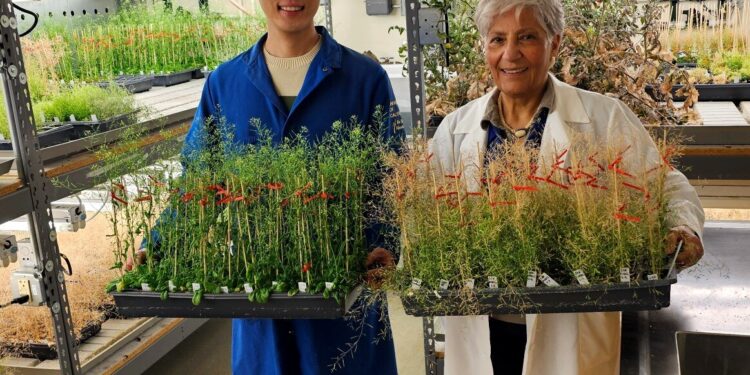UC Riverside researchers Heeseung Choi and Katie Dehesh holding young, green and old, yellow Arabidopsis plants in the lab. Credit: Katie Dehesh/UCR
Scientists have known about a particular organelle in plant cells for more than a century. However, UC Riverside scientists have only just discovered this organelle’s key role in aging.
The researchers initially sought to understand more generally which parts of plant cells control plant responses to stress from factors such as infections, too much salt or too little light. By chance, they discovered that this organelle and a protein responsible for maintaining it control the survival of plants when they are left too often in the dark.
Because they did not expect this discovery, described in a Natural plants journal article, the research team was delighted.
“For us, this discovery is very important. For the first time, we have defined the profound importance of an organelle in the cell that was not previously involved in the aging process,” said Katie Dehesh, Distinguished Professor in molecular biochemistry at UCR and co-author of the new paper.
Sometimes described as looking like a pile of deflated balloons or fallen lasagna, the organelle called the Golgi body is made up of a series of cup-shaped membrane-covered sacs. It sorts various molecules in the cell and ensures that they arrive at the right places.
“The Golgi are like the post office of the cell. They package and send proteins and lipids where they are needed,” said Heeseung Choi, a researcher in UCR’s Department of Botany and Plant Sciences and co- author of the new study. “A damaged Golgi can create confusion and disturbances in the activities of the cell, affecting its function and health.”
If the Golgi is the post office, then the COG protein is the postman. This protein controls and coordinates the movement of small sac “envelopes” that carry other molecules around the cell.
Additionally, COG helps Golgi bodies attach sugars to other proteins or lipids before they are sent elsewhere in the cell. This sugar modification, called glycosylation, is crucial for many biological processes, including the immune response.
To learn more about how COG affects plant cells, the research team modified certain plants so that they could not produce it. Under normal growing conditions, the modified plants grew very well and were indistinguishable from unmodified plants.
However, depriving plants of light means they are unable to produce sugar from sunlight to fuel their growth. When exposed to excessive darkness, the leaves of the COG-free mutant plants began to yellow, wrinkle, and thin, a sign that the plants were dying.
“In the dark, the COG mutants showed signs of aging that usually appear in unmodified wild plants around the ninth day. But in the mutants, these signs showed up in just three days,” Choi said.
Reversing the mutation and returning the COG protein to the plants quickly brought them back to life. “It’s like nothing happened to them once we reversed the mutation,” Dehesh said. “These responses highlight the critical importance of COG protein and normal Golgi function in stress management,” Choi added.
Part of the excitement about this discovery is that humans, plants, and all eukaryotic organisms have Golgi bodies in their cells. Now, plants can serve as a platform to explore the intricacies of the Golgi’s role in human aging. For this reason, the research team plans further studies into the molecular mechanisms behind this study’s findings.
“Not only does our research advance our knowledge of how plants age, but it could also provide crucial clues about aging in humans,” Dehesh said. “When the COG protein complex is not functioning properly, our cells can age more quickly, just like what we observed in plants when they lacked light. This advance could have far-reaching implications for the study of aging and age-related diseases.
More information:
Hee-Seung Choi et al, COG-imposed Golgi functional integrity determines the onset of dark-induced senescence, Natural plants (2023). DOI: 10.1038/s41477-023-01545-3
Provided by University of California – Riverside
Quote: The keys to plant aging are hidden in the leaves (January 17, 2024) retrieved on January 17, 2024 from
This document is subject to copyright. Except for fair use for private study or research purposes, no part may be reproduced without written permission. The content is provided for information only.



